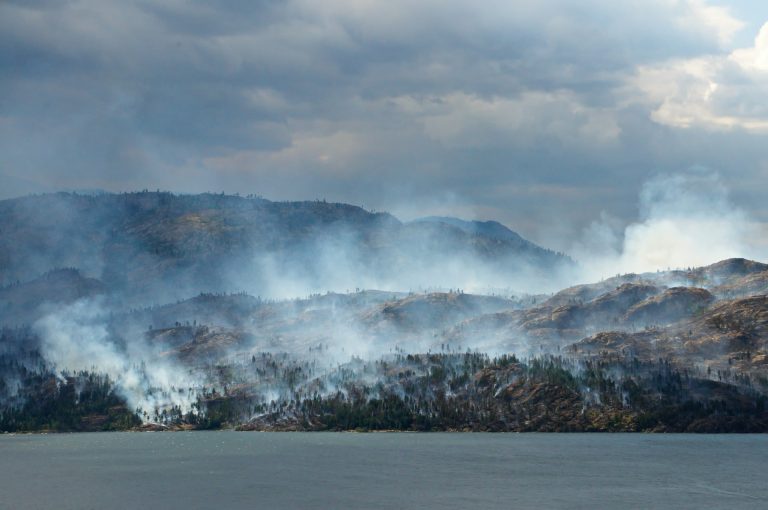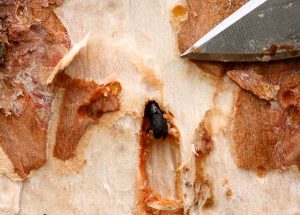
Forests fires are a natural occurrence that can benefit local ecology by removing the litter layer, replenishing nutrients, and controlling the spread of disease and insect infestation. Often forest managers will promote the health of the forest with prescribed burning. However, current forest fire trends indicate that fires have become too large, powerful and uncontrollable resulting in more damage than benefit [1]. These mega-fires are responsible for forest and biodiversity loss, as well as water quality and quantity issues that further jeopardize drinking water for humans and animals. In the event of a forest fire, trees and soil can be burnt to the extent that hydrological process such as transpiration and infiltration cannot occur. The result is heavily contaminated water runoff and soil erosion that enters lakes and rivers that provide drinking water supply to populated areas [2]. The persistence of mega-fires in both Canada and the United States has had devastating impacts on aquatic ecosystems and drinking water supplies. For example, the mega-fire that occurred in Slave Lake, Alberta in 2011 burned 790,000 hectares of forest and impacted drinking water supply to the extent that the only water source available to residents was bottled water. The devastating impact of mega-fires, such as in Slave Lake, point to the need for improved forest and watershed management to ensure forest fires can be contained and water supplies protected.

“Mountain Pine Beetle over-winter survival results released” by Government of Alberta is licenced under CC BY 2.0.
The mountain pine beetle (MPB) is a small bark beetle (approximately 4.0 to 7.5 mm in length) that is responsible for the destruction of mature pine forests throughout North America [3]. By introducing blue-stain fungi to the different species of pine trees, MPB’s destroy the connective tissue of these trees further preventing natural processes such as transpiration. As a result of this infestation, pine trees die within a month of becoming infected with the MPB. Both British Columbia (B.C.) as well as parts of Alberta have experienced spreading MPB infestations that have required swift action by government and forestry operators.
In recent years, MPB infestations have worsened due to climate change and moderate winter temperatures that have enabled beetle populations to survive year-round [4]. Specifically, the threat of expansion of the MPB jeopardizes the longevity of forestry resources and ecological integrity of watersheds and forest ecosystems. The hydrological cycle can also be impacted given the need to clear-cut infested forests. These open areas result in changes to snow accumulation, soil moisture, and runoff that have negative consequences on water quality, freshwater ecosystems and public safety [5]. To address the environmental, social and economic challenges posed by the MPB, government policy must be met with sustainable forestry practices to mitigate the consequences of MPB infestations.
In 2007, the Government of Alberta released an Action Plan and Management Plan to protect forest health by reducing the spread of the MPB in the Eastern Slopes region and into the Boreal Forest. Initiatives pursued in these plans include; forest management, reforestation, rehabilitation plans, log management and transport restrictions. Furthermore, infected forests are separated into three zones (leading edge zone, holding zone, and salvage zone) where specific actions can be taken to ensure effective and expedient response. Additionally, government and industry response to MPB infestations require collaboration so that forest management is timely and treatments can be applied. Specific treatments for MPB infestations include; tree removal, debarking and burning to destroy beetles, applying pheromones to repel beetles, as well as monitoring and detection techniques [6]. In addition to these government and industry initiatives to limit the MPB’s presence in Alberta, individuals are encouraged to keep their pine trees healthy, peel away bark to expose beetles to the cold, remove infected trees and seek professional help to apply pheromones that repel beetles. Without applying these prevention and treatment techniques, Alberta’s pine forests are at risk of being destroyed by the MPB which would have significant social, environmental and economic consequences.
Forest harvesting is when trees are removed from the landscape for economic and social purposes. The impact of this practice, however, is significant and requires improved management practices. When forests are removed from a landscape, this affects the soil, surrounding vegetation, overall watershed characteristics, and wildlife habitats [7]. Forest harvesting impacts the physical and biological qualities of soil because wind erosion reduces top soil, causes soil compaction that limits air and water flow, rutting and puddling that are caused by forest equipment changing the surface hydrology of soil. To reduce these impacts, forest harvesters are encouraged to plan when and how tree harvesting will occur to reduce overall land disturbances.
There are also significant impacts on the watershed that include; runoff, increased flooding, erosion and sedimentation, water quality degradation, damage from equipment, changes in soil chemistry, and cause wetlands to dry [8]. Trees help watersheds to stabilize river banks, absorb water, and provide canopies for vegetation, therefore, removing forests can damage river banks and increase sedimentation. To reduce these impacts, harvesters must carefully plan their logging practices and use management strategies such as working away from lakes and streams to limit their impact on the land.
The cumulative impact of these forest disturbances has a further influence on water quality and quantity that can compromise a forests function. The increase in MPB infestations, harvesting and large wildfires results in reduced forest cover, therefore, fewer opportunities for water to be absorbed into the ground and trees. Flooding does not always negatively impact forests. The resiliency and strength of forests are able to withstand flood waters and absorb excess water to limit downstream flood damage. When forests are mass harvested, however, this presents challenges to the quantity and quality of water both in and out of flood seasons.
With fewer trees on our landscape, the potential for flooding increases, especially in the spring time when snowmelt and rainfall combine to create peak flows in Alberta’s river systems.
In the event of flooding, water quantity exceeds normal in-stream flow requirements and causes erosion on riverbanks. As a result, water quality becomes poor as debris, silt and mud are carried downstream. Alternatively, in times of low flow, forests provide water storage and absorption opportunities such as in groundwater and evapotranspiration. When trees are harvested, however, water seeps into the ground more quickly resulting in increased water tables.
During a flood, forests function as a natural mitigation method to reduce excess water by absorption. When these trees are taken off the landscape, however, flood waters can increase in intensity resulting in water quality and quantity issues.
Forests are an integral part of the hydrological cycle, influencing how water is moved throughout the landscape. While it is very difficult for this process to be permanently disrupted or damaged, current issues such as climate variability can impact the biodiversity of forests. Forests in Alberta and throughout the world are capable of withstanding extreme weather and even minor wildfires, which can in turn improve soil nutrients. However, severe wildfires and drought conditions pose the greatest threat to forests, their biodiversity and overall function. In the event of a severe drought or wildfire, it is difficult to regain forest growth and biodiversity which, impacts the overall health of trees and forests. In addition to climate variability and uncertainty, warmer weather encourages the spread of pests and disease. For example, the Mountain Pine Beetle normally dies in cold temperatures limiting the extent of this problem. However, in warmer weather this pest strives and continues to impacts trees. While forests can withstand extreme weather events, future issues with severe drought and wild fires could leave a lasting, negative impact on forests both globally and in Alberta.
Alternatively, future issues facing the forestry industry include increases in consumer demands, implementing sustainable business practices, and addressing water supply and quality concerns. To address these issues, the forestry industry must continue to address the social, environmental and economic impacts of their business while providing forestry products to Albertans. To achieve this standard, the Alberta Forest Products Associations’ 2011 Water CEP Plan identified the following opportunities to improve water use in the industry; reduce intake, improve efficiency, improve productivity and improve knowledge of CEP [9]. Other sustainable business practices pursued by the industry include; policies to balance forest harvesting by promptly replanting new trees, working with government to control and mitigate Mountain Pine Beetle infestations, and promote forest and watershed management [10]. Looking ahead, the forestry industry can utilize new technology that improves efficiency and productivity. In Alberta, options for new technology include a pilot project to discover the applications of crystalline nano-cellulose fibre-based products to provide sustainable solutions to bio-materials based on forests products [11]. In all, the forestry industry in Alberta faces challenges in ensuring their business practices remain sustainable while meeting the growing demands of Albertans.
We provide Canadian educational resources on water practices to promote conservation and sustainability. Our team crafts current and relevant content, while encouraging feedback and engagement.
The Canada WaterPortal is a registered charity, #807121876RR0001
We recognize and respect the sovereignty of the Indigenous Peoples and communities on whose land our work takes place.
© 2025 All Rights Reserved.